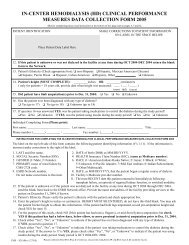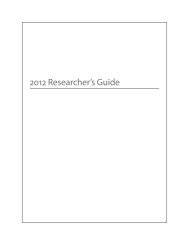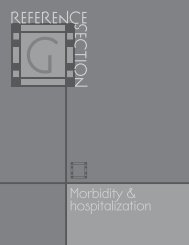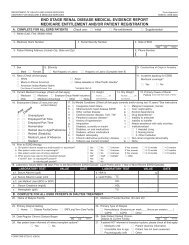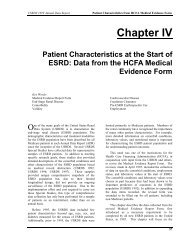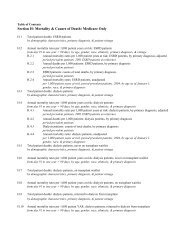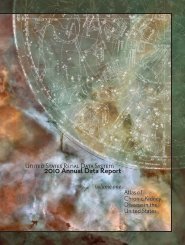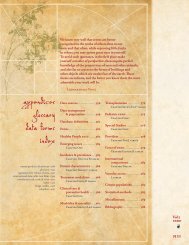Download - United States Renal Data System
Download - United States Renal Data System
Download - United States Renal Data System
Create successful ePaper yourself
Turn your PDF publications into a flip-book with our unique Google optimized e-Paper software.
How the Payer Category is Determined<br />
The payer history SAF in the USRDS Core CD records the<br />
sequence of payers for each patient. Table 4.2 shows the variables<br />
included in these files. Each record in the file represents<br />
a time period covered by a particular payer. Any change in<br />
payer or dual eligibility status results in a new record.<br />
Table 4.2 Payer History SAF Variables<br />
Variable Description<br />
USRDS_ID USRDS Patient Identification<br />
BEGDATE Beginning date of a payer period<br />
ENDDATE Ending date of a payer period<br />
PAYER Payer for the period<br />
MCARE Payer includes Medicare (Y/N)<br />
DUALELIG Payer includes Medicare and Medicaid (Y/N)<br />
Because several data sources are used to determine payer<br />
history, more than one payer may be reported for any given<br />
time period. In constructing the history, the following conventions<br />
are followed:<br />
♦ The sequence begins with the first ESRD service date.<br />
If the patient has died, the end date for the last patient<br />
record is the date of death. If the patient has not died,<br />
the end date is missing from the patient’s last record.<br />
♦ If the payer on the first service date is unknown, and the<br />
unknown time period lasts for up to and including 180<br />
days (6 months), the initial payer is assumed to be the<br />
same as the payer for the next period.<br />
♦ If the reported end date for a payer is missing in the<br />
data source, the payer is assumed to continue sharing<br />
responsibility through the date of death or through the<br />
period of available payer information, whichever comes<br />
first.<br />
♦ If more than one payer is identified for a time period,<br />
and one is MSP, the payer for the period is assumed to<br />
be MSP.<br />
♦ If more than one payer is identified for a time period,<br />
and one is HMO, the payer for the period is assumed<br />
to be HMO. If both HMO and MSP are indicated, MSP<br />
takes precedence.<br />
♦ If consecutive payer sequences have the same payer and<br />
dual eligibility status, they are collapsed into one time<br />
period, starting with the beginning date of the first and<br />
ending with the end date of the last.<br />
♦ Unlike the treatment history file, the payer history file<br />
does not require a payer to continue for any specific<br />
time period to be considered stable. Therefore, all<br />
changes in payer are reported. At their discretion, users<br />
may apply additional rules to manage the payer history<br />
sequence.<br />
Gaps in the Payer History<br />
Some patient payer histories include gaps with Other/Unknown<br />
as payer between sequences with identified payers.<br />
This might occur for several reasons, similar to the explanations<br />
for gaps in the treatment history:<br />
♦ Some patients recover enough renal function to discontinue<br />
dialysis and the USRDS database may contain no<br />
payer information for time periods off dialysis.<br />
♦ Successful transplant patients may not have payer information<br />
reported in the data sources because Medicare<br />
eligibility terminated after three years of a functioning<br />
graft.<br />
♦ A patient may leave the country and become lost to follow-up.<br />
♦ A patient may die and the death data may not reach the<br />
USRDS.<br />
♦ CMS may not capture payer information.<br />
♦ Reporting, data entry, and clerical errors may obscure<br />
the record of first service date and the corresponding<br />
payer.<br />
♦ Errors in patient identification may cause data for a<br />
single patient to be split between two patients or to be<br />
associated with the wrong patient.<br />
If a patient is alive but the last reported payer in the data<br />
sources ends on a date before the reported data extraction<br />
date, an additional payer sequence is created with Other/Unknown<br />
as payer to extend the patient’s payer history. Thus,<br />
only patients who have died have end dates in their last payer<br />
sequences, and the last end date is the date of death.<br />
Some patients have no identified payers at all. Their payer<br />
histories are represented in the file as one payer sequence,<br />
starting at first ESRD service date, with missing end date and<br />
Other/Unknown payer.<br />
Section 5 · Transplant Process and Outcomes<br />
Transplant patients constitute a unique subset of the ESRD<br />
population and are often studied separately from dialysis<br />
patients. Researchers may wish to simply count the number<br />
of transplant events that meet certain criteria, or calculate<br />
transplant event rates and survival probabilities. Using the<br />
USRDS transplant data, researchers can obtain information<br />
on both transplant events, such as donor and recipient characteristics,<br />
and patient- and graft-related outcomes.<br />
<strong>Data</strong> Sources<br />
Basic transplantation variables are contained in the Transplant<br />
file on the Core CD. Transplant event data are combined<br />
from various sources including CMS (PMMIS/REBUS files)<br />
and UNOS. Before 1988, CMS was the primary source for<br />
all transplant event data. Between 1988 and 1993, both CMS<br />
and UNOS collected information regarding transplant events.<br />
Since 1994, UNOS has been the primary source for all transplant<br />
event data (see figure 5.1).<br />
Reconciliation of CMS and UNOS Events<br />
The USRDS has implemented a decision algorithm that<br />
reconciles identical transplant events when multiple sources<br />
contain conflicting information.<br />
♦ Before 1988, all transplant events found in CMS PM-<br />
MIS/REBUS transplant files are used.<br />
♦ After 1994, all transplant events found in the UNOS<br />
files are used.<br />
26 e Sections 1-9




